The beginning of the creation of the second, atheistic
Khazaria was marked by the Russia-wide pogrom which echoed from
one end of the endless Orthodox Christian Empire to the other. The main
blow was aimed at the Orthodox Church and the monarchy in the person of
the Anointed One, the last Russian Emperor Nicholas
II and his family.
Power, as in the First Khazaria, once again ended up in the
hands of the "eternal civilizers". But this time the power grab was not
gradual and painless, but accompanied by rivers of blood. And there can
be no talk of the "prestigiousness" of any religion: militant atheism -
that was the "religion" adopted by the builders of the Second Khazaria.
I've already written about the "national character" of this
historical period in The Jewish Syndrome-2. But before citing
from that book, I'd like to explain why I resort to such frequent
"self-citation" in this work.
Each of my books contain the main axioms of my "Three
Khazarias" theory, but in "scattered" form. Nonetheless, an attentive
reader capable of analysis could independently arrive at its discovery.
So why didn't I present the theory in its "finished form" from the very
beginning? The more you immerse yourself in the matter, the more you'll
understand that the stage-by-stage method I've chosen for my "Khazaria
Studies 101" is the only possible one: the mountain of evidence is
simply too overwhelming and irrefutable -- and simply too frightening
for many to digest, I'm afraid...
...So February 1917 ended in the complete victory over the
Orthodox Monarchy which anti-Christian forces had so long cherished. But along
with it, the Bolshevik "genie" was released from its bottle. The "authors" of
the February Revolution, International Jewry, which
had relied on its blood ties with Jew-internationalists (they'd mistakenly
placed their bets on Trotsky), and atheistic
Masonry, which was hoping on its ideological ties
with Bolshevism, had underestimated this factor. October not only conquered
February, but went much further in its battle against Orthodoxy.
Marxism-Leninism was not so much a pragmatic political theory as a utopian
"religion with a minus sign". It was just this "religiosity"
which accounts for the stable immunity of the Bolsheviks against Western liberal
influence. This was a peculiar, modified Jewry, an internationalist
hypostasis of Jewry. But none of this prevented international financial circles
from correctly understanding the "mission" of the Bolsheviks and participating
to completely insure themselves against the restoration of the monarchy.
It's also worth mentioning that the Bolshevik elite of the
time was composed of two groups: 1) Lenin
and his cohorts (who were spirited into Russia in 1917 by the
Germans); and 2) Trotsky and company (who came from America). But in
both cases it was the Schiff-Warburg Jewish
banking elite who financed them.
Trotsky expressed his delight and gratitude at the
generosity of his American "friends" in his memoirs:
"I ended up in New York, in the prosaic-colorful city of capitalist
automatons, where the aesthetic of cubism ruled the streets and the
moral philosophy of the dollar ruled the hearts. New York impressed
me, inasmuch as it expresses the spirit of the contemporary age more
than any city... I left for Europe with the feeling of a man who was
allowed a glimpse into the smithy where the fate of humanity will be
forged..." (L. Trotsky, "My Life. An Experimental
Autobiography", Berlin, 1930, v.1)
...Naturally, in accepting the generous "sponsorship" of
Jewish financial magnates, both Trotsky and Lenin sincerely believed
that the bankers, in cosmopolitanizing the world, were
"unconsciously" helping the cause of communist revolution. In fact,
the latter knew exactly what they were doing. By placing their bets
on the Bolsheviks, they understood perfectly well that the
revolutionaries, in destroying the world of Christian values, were
working toward the establishment of the world-wide power of the
banker-"blacksmiths". The events which followed only confirmed how
correct their calculations had been: Orthodox Monarchy was
irreversibly ground into the dust, the Anointed One crucified on the
Toppled Cross, and the very Name of God given over to diabolical
anathema.
Such of Lenin's utterances as: "Any
religious idea, any idea of a deity... is indescribably vile, the
foulest contagion"
say a lot, don't they? This is how he browbeat
Gorkiy for his "god-seeking". Lenin finished his tirade with
the words:
"devilishly annoying". And it's no accident that in
the first years of the Soviet regime a monument to Judas was erected
in the city of Sviazhsk. The children's writer Henning Keler, who
witnessed the unveiling ceremony of this monument, described it
thusly: "The local party functionary debated for
a long time to whom the monument should be made. Lucifer was
considered to imperfectly embody the idea of communism; Cain was too
legendary. So they decided on Judas, as a completely historical
figure. He was depicted full-height with his fist raised into the
air..."
The breakneck pace with which the Second Khazaria was built
was accompanied by a "shock wave" of destruction of Christian
shrines. The country's new masters raged on the ruins of demolished
churches; "Any religious idea, any idea of a deity..." was beaten
out of the brains of the newly "conquered" people; a new era dawned,
the era of atheism. The time had come for new "saints", to whom the
"foolish Khazars" were to bow down.
Here's how the godless "iconostasis" looked, through the
eyes of an unknown artist who produced an "Album of 30 photographs
of Bolshevik commissars" entitled "The Ukraine's Butchers" (The
captions under the portraits are the original ones given by the
artist):
The Ukraine's Butchers
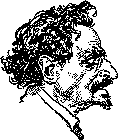
Leib Bronstein Trotsky, Minister of War
|

Ulyanov-Lenin, Chairman of the Council of People's Commissars
|
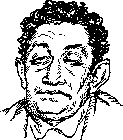
Zinoviev Apfelbaum-Radomysl'skiy, Chairman of the Northern Commune
|
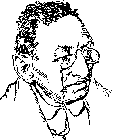
Moishe Uritsky, Chairman of the Special Commission (Cheka)
|

Viktor-Kopp, Soviet Representative in Berlin
|

Bela Kun, Chairman of the People's Commissariat of Ugorshchina
|
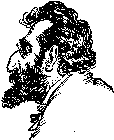
Martov-Cederbaum, Member of the Central Executive Committee
|

Yankel Yurovsky, Organizer of the Yekaterinburg Murders
|

Sukhanov-Gimmer, Member of the All-Russian Council of Soviets
|

Samuil Berkman, Bolshevik agent in America
|

Emma Goldman, Babushka
|

Levine-Nissen, Member of the Executive Committee
|

Tomsky-Honichsberg, Member of the All-Russian Council
|
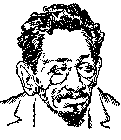
Sverdlov, Chairman of the All-Russian Council of Soviets
|

Axelrod, Commissar of Finance
|
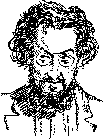
Schreider, Chairman of the Revolutionary Tribunal
|

Petrov-Weisbrot, Member of the Soviet peace delegation in Berlin
|
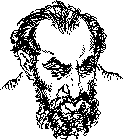
Steklov-Nakhamkes, Member of the Petrograd Executive Committee
|
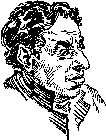
Revkin, Member of the Founding Assembly
|
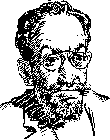
Bogdanov-Silberstein-Ioffe, Chairman of the Soviet peace delegation in
Brest-Litovsk
|
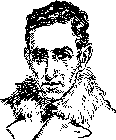
Katz-Kamkov, Member of the Central Executive Committee
|

Kamenev-Rosenfeld, Delegate of the Soviet delegation in Brest-Litovsk
|
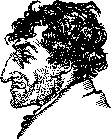
Avanesov, Secretary of the Executive Committee
|

Levin, Member of the Executive Committee
|

Parvus-Gelfand, Creater of Russian Bolshevism
|

Volodarskiy-Kogan, Member of the Petrograd Executive Committee
|

Steinberg, People's Commissar of Justice
|

Prostein, People's Commissar of Agriculture
|
|
|

Karakhan, Soviet Representative in Warsaw
|
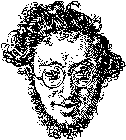
Radek-Sobelson, Bolshevik "wise elder"
|
|
After the civil war, which passed like a destructive cyclone
over the whole territory of the conquered Empire and the hungry
years of "War Communism" the Second Khazaria's period of prosperity
began. The "New Economic Policy" (NEP),
which gave rise to a boom in trade and let loose the forces of
private enterprise, marked the beginning of the the new state's
meteoric rise.
I won't go into detail in describing this period, whose
features are well-known, I'm sure, to anyone who knows their
history. I'll only mention that NEP in essence completely
contradicted the ideals of "freedom, equality and brotherhood",
under which the proletarian masses were let into battle by the
builders of the "bright future".
Stalin
It was then that the Georgian came to power. In 1927
Joseph Stalin expels Leo Trotsky from the country
and the fate of the Second Khazaria is practically sealed...
Here it would be appropriate to quote "Bolshevik wise elder"
Karl Radek, who commented Stalin's actions in the following
way: "Moses led the Jews out of Egypt, while
Stalin led them ... out of the Politburo".
What happens after that? A frontal assault begins on the
so-called "Trotskyite-Leninist Old Guard"; "Bolshevik commissars"
are mowed down wholesale; the era of the Stalinist socialism begins.
Rejecting the "Khazarian" path, Stalin invented his own
"blueprint" for the further development of the Land of Soviets. The
three pillars used by the "father of peoples" to base this
governmental entity, unique in human history, were the following: 1)
collectivization of agriculture; 2) industrialization; and 3)
centralization of power. The third "pillar" deserves special
mention, for centralization was the principal of Stalin's
achievements. It allowed him to nullify the main conquest of the
builders of the Second Khazaria, namely, the destruction of the
autocratic model of state administration. By organizing a strict
"power vertical", Stalin in effect reanimated the autocracy. He
created his own "know-how" -- "socialist monarchy", defining the
political system in the country he ruled in his own words as a
"socialist empire".
One has to give Stalin his due for stopping the campaign of
mockery against Orthodoxy, carried out so relentlessly by his
predecessors, once he had achieved unbridled power. One story,
repeated in many sources, is indicative of this:
...Once Kaganovich was showing Stalin a project for the
rebuilding of Red Square. He explained that the fake-classical building of the
Historical Museum would have to be demolished, then he removed the GUM shopping
center from the model, where a grandstand was to be built. When Lazar Moiseevich
grabbed the cupola of St. Basil's Cathedral, intending to show where it needed
to be relocated, Stalin literally exploded: "Put that back,
you dog!"...
In this fashion, by dint of titanic effort and tremendous
sacrifices Stalin was able to reverse the course of history which had been
charted out for us, as you'll soon see, for a century in advance.
Bold emphasis is the author's. Colored highlighting
provided by oag.ru.
Previous
Table of Contents
Next


![]()
![]()

![]() - A must see!
- A must see!
![]()

![]() - Important collection
- Important collection

![]() Hezbollah
- Lebanon
Hezbollah
- Lebanon![]() Nation of Islam
- U.S.A.
Nation of Islam
- U.S.A.![]()
